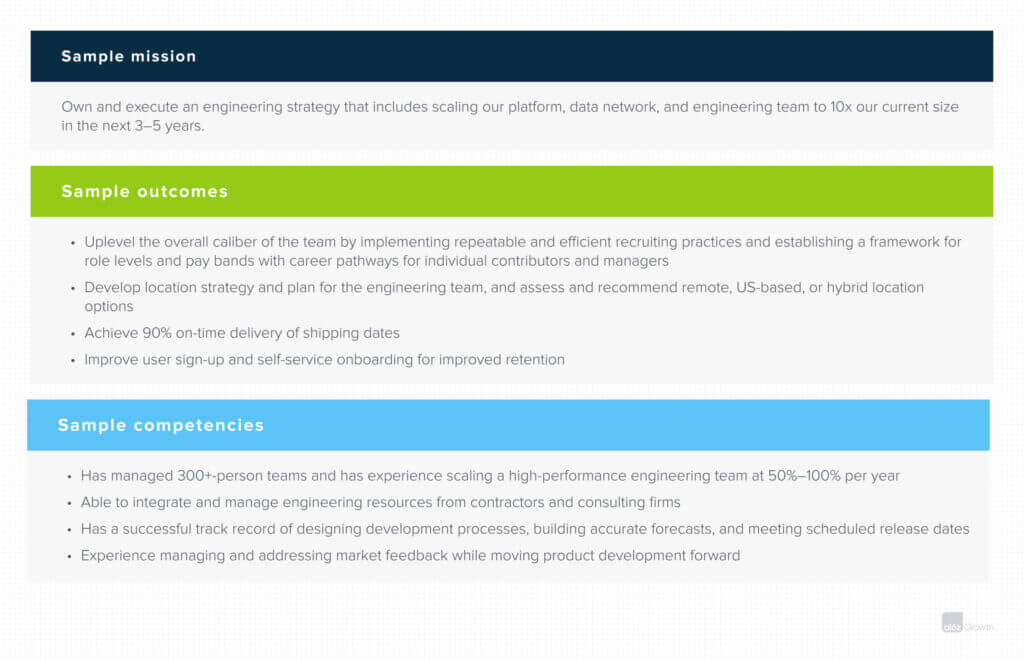Note: engineering leaders’ titles tend to be inconsistent across companies. It’s common for founders to assume the role of chief technology officer (CTO), who either runs the day-to-day work of engineering or focuses on a long-term technological vision. While this is a guide to hiring an SVP of engineering, it applies to the growth-stage hire who sits on your executive team and is responsible for the people and productivity management of your engineering team.
As your company scales and your engineering headcount increases, Conway’s Law—often summarized as “ship your org chart”—takes effect. A growth-stage engineering leader understands that how you structure your engineering org will be reflected in your product and partners with your CEO, CTO, or CPO to understand, on a first-principles basis, what products your company needs to bring to market, then translates those into an org structure, reporting lines, team composition, and engineering process that nail product quality and shipping deadlines.
If you eliminate boundaries and have big teams, then it’s hard to make progress because n-squared people need to communicate and get on the same page. On the flip side, if you want to move super fast and have super small teams, they can get alignment around 5 or 6 people and run very fast. But then all the things they’re building are inconsistent and it’s hard to make all the products work well together. It requires you to understand what you want to build and build your org chart around what you want to build.
—Ali Ghodsi, CEO of Databricks, Boss Talk #2
Engineers, especially in startup environments, want to do what’s best for the company, which can often mean late nights, engineering debt, and burnout. As the manager of what is generally the greatest human capital investment in your company—your engineering team—your SVP of engineering not only manages resources, they set appropriate—and realistic—expectations about costs and when they can deliver with the resources they have. A great SVP of engineering adds sanity to the engineering process. They shift the engineering culture from a bootstrapped, frenetic early-stage grind to something more systematic. Ultimately, they’re the advocate the engineering department needs to keep morale high and development rolling and enable long-term success.
While scaling a technical organization, it’s challenging (if not impossible) to determine delivery dates, hit all the right dates, and prioritize development by group consensus. This doesn’t even include the importance of setting the right culture, which is critical for retaining engineering talent. Your SVP of engineering owns all of these things and is responsible for shipping quality products while giving the rest of the organization transparency into the process.
—Martin Casado, a16z general partner, Hire a VP of Engineering
TABLE OF CONTENTS
When to hire
TABLE OF CONTENTS
In the early stages, most companies have an operations-focused engineering leader who is primarily focused on understanding what to build, how to build it, and how to ship it. Once your company is operating at scale, however, you need a leader who can build and ship a cohesive product across a range of teams and engineers.
Below are a few signs that companies might need to hire an SVP of engineering:
- Your technical CTO or cofounder wants to focus more on tech and less on running the engineering function or managing the team. We’ve seen many growth-stage companies with technical founders hire an SVP of engineering to manage the engineering team and function so the more technical founder can stay closer to the product.
- Your rate of shipping slows or you’re missing key dates. This is generally an indication that your org structure and processes aren’t keeping pace with the growth and scale of your company.
- You move to a multiproduct structure and need an engineering leader who can manage a diverse group of senior engineering leaders whose incentives aren’t necessarily aligned. Different engineering leaders building different products will lobby for resources and priority, and your SVP of engineering needs to allocate your engineers and get those different groups working toward the same product vision.
Writing the MOC
We discuss writing a mission–outcomes–competencies (MOC) document in greater detail in The Hiring Process.
What experience should you look for in your SVP of engineering?
The nature of your product will be the biggest factor in determining what specifically you need in an engineering leader. If you’re building a consumer fintech app, for instance, your SVP of engineering will need to understand how to build out products with robust security features and ensure that your data management practices are compliant with certain regulations. If you’re building a vertical SaaS product with payments processing, you’ll likely want someone who has experience developing a clear, clean API, deep documentation, and an easy-to-use product. If you’re building a cutting-edge LLM, you’ll need a leader who can attract and retain top-notch researchers and create an engineering process that can translate the complex tech of an LLM into a consumer- or enterprise-facing product. On the other hand, a SaaS application company will want a leader who works on a shorter timeline to ship and iterate quickly.
For enterprise products, especially infrastructure products, it is critical to integrate with different systems, from workplace collaboration tools and customer relationship management (CRM) tools to marketing automation platforms and business intelligence and automation tools. If you’re building an enterprise infrastructure product, you’ll want a leader experienced in working with more complex architectures and integrations, strict security and compliance requirements, and stress-testing products before batch shipping. If you’re selling that product to bigger customers with higher average contract values (ACVs), you’ll generally want a leader who can be brought in for key sales meetings in order to close deals.
What core competencies should you look for in your SVP of engineering?
Any all-star SVP of engineering:
- Is part recruiter, part adviser, and part motivator. While attracting and hiring talent is key for almost any growth-stage executive, it’s particularly important for an SVP of engineering because engineering is generally where most late-stage head count is allocated in order to scale at the pace of the company’s growth. As you rapidly scale, your products are only as good as the engineers you hire to build them. Their ability to attract, coach, and retain high-caliber engineers is their core skill set.
- Sets up the problem space for engineers. A good SVP of engineering knows that engineers are creative problem-solvers by nature. Rather than prescribe solutions, they define the problem space, lay out who your customers are and what they want from your product, and give your engineers the flexibility to develop and iterate on solutions.
- Is technical enough to gain the respect of their engineers and understand how the entirety of the codebase comes together in your product. From a technical perspective, your SVP of engineering typically manages the codebases, cross-product dependencies, technical debt, interoperability, and security of multiple product lines to ensure that your internal resources aren’t overtaxed and your customers have a seamless experience with each of your products.
- Has a track record of building successful cross-functional relationships and can influence the executive team on the strategic technical direction of the company.
- Excels at implementing replicable processes. Generally, technical orgs run agile development to create clarity for teams.
- Can explain deeply technical concepts to nontechnical peers and customers. This is especially important for leaders in sales-led companies who will likely be brought in to close high-stakes deals.
What functions should my SVP of engineering own?
Your SVP of engineering generally owns some or all of the following functions:
- Engineering
- Product data science (if data science or AI/ML is a core part of the product) and data analytics
- Machine learning
- Technical support and project management
- Infrastructure and operations
- Product security
- Technical product documentation
- Quality assurance and testing
- Research and development
Sample MOC
Setting up your SVP of engineering for success
We cover best practices in The Hiring Process, but we’ve included some recommendations below for what different members of your executive team may want to focus on when interviewing engineering leaders.
Do they have the appetite to drill into the details?
One of the most common failure modes we see when growth-stage companies hire an SVP of engineering is hiring someone from a big company who is an expert at managing schedules and ship dates but not at understanding the product and who builds it. It’s important for the CEO and product leader to test to see if your candidate still has the hunger and ability to get into the nitty-gritty and details. Will they meet every single engineer on your team, even if that means doing hundreds of one-on-ones over a multi-quarter timeline?
Can they pull together accurate execution estimates?
When it comes to building a new product, your product leader will make recommendations about what to build and why based on their knowledge of the market and the customer. Your engineering leader needs to pull together execution estimates—both head count and CapEx investments—to ascertain what’s feasible for the engineering org to build, based on available resources. Forecasting these estimates incorrectly can lead to pileups of technical debt and burned-out engineers, so it’s critical that your candidate can describe, in detail, how they’ve pulled together execution estimates in the past.
Do they have the right technical expertise? Do they know how to structure the problem space for the team?
If your candidate can’t establish credibility with your technical leadership and best performers, you risk losing some of your best engineering talent and kneecapping whatever progress your engineering org could make. To assess a candidate’s technical ability, it can be helpful to include a top engineer in the interview loop. This can also be a great way to get your highest performers on board with the hire. Your SVP of engineering should also have strong enough technical chops to understand how your codebase fits together and can win the respect of your all-star engineers.
Do they understand how customers use the product? Can they help close key customers?
Your SVP of engineering should understand the ins and outs of how your product works from the perspective of the customer in order to build and iterate on it—particularly for enterprise companies—and to help close sales deals. Include your sales leader in the interview loop to check whether a candidate can translate technical jargon into accessible explanations. A great SVP of engineering can explain the value of your product in terms of the business problems it solves. Then, when your SVP of engineering joins, consider facilitating a way for them to shadow your product’s onboarding process or common workflows, to make sure they’re aligned with the sales team on how customers use the product.
Many thanks to Will Larson and Jason Rosenthal for contributing their hard-earned wisdom and expertise to this guide.
Further reading
We’ve drawn insights from some of our previously published content and other sources, listed below. In some instances, we’ve repurposed the most compelling or useful advice from a16z posts directly into this guide.
On Fear and Leadership—Product to Sales CTOs & CEOs, a16z podcast with Martin Casado, Armon Dadgar, and Sonal Chokshi
How do you know if your leaders are capable of evolving with your company? When is the right time to bring on a CTO (if any)? On this episode of the a16z podcast, Casado and Dadgar discuss leadership transitions, trade-offs, and whether (or not) it’s a good idea to bring on a CTO.
Hire a VP of Engineering, Martin Casado
Your engineering team is the heart of your company, which means you can’t afford to wait too long to hire a VP of engineering. Here, Casado draws on his own experience to break down critical parts of an engineering leader’s job, so you know what to look for when making this critical hire.
An Elegant Puzzle: Systems of Engineering Management, Will Larson
Managing an engineering team comes with its own unique challenges. Here, Larson addresses some of the specific challenges engineering leaders face in rapidly growing companies, including paying down technical debt, growing your people, team size, and more.





